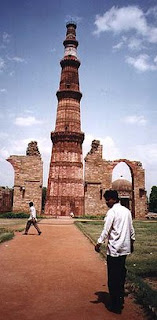According to some historians Kankwari Fort within the Sariska National Park in Alwar is the place where Dara Shikoh was held captive by Aurangzeb
As soon as the fifth Mughal emperor Shah Jahan fell ill in September, 1657, it
sparked a deadly war of succession among his four sons – Dara Shikoh, Shuja,
Aurangzeb and Murad. In this fratricidal war of succession, his two daughters
Jahanara and Raushanara sided with Dara Shikoh and Aurangzeb respectively.
At
the time of the emperor’s sickness, his eldest son Dara was at his bedside in
Agra where he resided at the court. Shah Jahan was very fond of Dara and in
normal circumstances the latter would have been his successor. Dara was a man
of liberal persuasions and spent time in scholarly pursuits. This made him the
adversary of the orthodox elements in Islam. Though intelligent and brave,
Shuja, then governor of Bengal, loved the life of ease and was pleasure
seeking. The youngest, Murad, was the governor of Gujarat. He was somewhat liberal compared to Aurangzeb but
was devoid of the qualities needed for leadership. He was also addicted to hard
drinking. Aurangzeb was the ablest of the brothers. Apart from being a person of intense energy,
he claimed the Mughal throne as zealous champion of Sunni orthodoxy.
When Shah Jahan fell ill, the three absentee brothers
suspected that their father had already died and the news had been suppressed
by Dara.
Consequently, Shuja proclaimed himself emperor at Rajmahal, the then capital of Bengal and marched with an army and fleet towards Agra.
He reached Benares on January 24, 1658 and was defeated by the army under
Sulaiman Shikoh, son of Dara at Bahadurpu.
Murad did the same at Ahmedabad on 5th
December, 1557 and struck coins and had the Khutba read in his own name.
Aurangzeb entered into an alliance with Murad. Under the agreement the empire
will be partitioned whereas Punjab, Afghanistan, Kashmir and Sindh was to be
given to Murad apart form the one-third of the booty. The terms of the
agreement were solemnized in the name of God and prophet.
In February 1658, Murad’s forces joined Aurangzeb near
Ujjain. Their combined forces signally defeated the imperial forces, sent to
contain them under the leadership of Raja Jaswant Singh of Jodhpur and Qasim
Khan, at the battle of Dharmat, fourteen miles south-south-west of Ujjain, on 15th
April 1658. The proud wife of Jaswant Singh refused to give him shelter because
he fled from the battle-field.
After Dharmat, Aurangzeb and Murad crossed the Chambal
river and were on their way to Agra. As they reached the plains of Samugarh, eight
miles form Agra, they were confronted with Mughal forces under Dara. In the battle of Samugarh, which took place
on 29th May, Dara was decisively defeated and he fled from Agra. He was
chased by the Mughal forces from place to place. At last he was executed in September
1659 on the charge of heresy and infidelity.
Soon after his victory at the battle of Samugarh, Aurangzeb
marched to Agra and took possession of the Agra fort on the 8th June
1658. All efforts by Shah Jahan for an amicable settlement for accession to
throne ended in vain. Shah Jahan was deprived of throne and was made a prisoner
by Aurangzeb who died there on 22nd January, 1666 at the age of
seventy –four.
From Agra Aurangzeb set out for Delhi on the 13th
June 1658. On the way he made Murad fall into a trap. Murad was apprehended on
June 25, 1658 and was kept first in the fort of Salimgarh whence he was removed
to the Gwalior fort and was executed on the 4th December, 1661 on
the charge of murdering Ali Naqi who was Murad’s one time Divan.
Already after Murad’s capture, Aurangzeb had crowned himself
as emperor in Delhi on 21st July 1658 in Sheesh Mahal in Delhi's Shalimar Bagh and assumed the title of
Alamgir. But his formal coronation took place on June 5, 1659.
As motioned earlier Shuja was defeated by Dara’s son Suleiman
Shikoh, it was now turn of Aurangzeb to get rid of him. Aurangzeb routed Shuja
at Khajwah near Allahabad on the January 5, 1659. The defeated prince fled to
Arakan where he was killed by the Arkanerese in May 1660. Prince Muhammad,
Aurangzeb’s eldest son, who sided with Shuja for a time, was
imprisoned for life and died in 1676.






